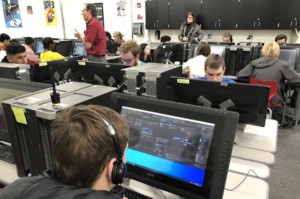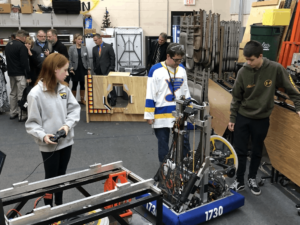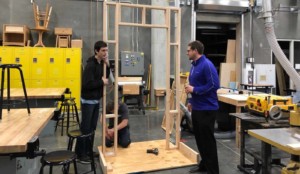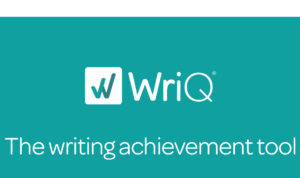Real-World Writing Doesn’t Start with a 5-page Paper

By Chuck Hensley and Larue Fitch.
You’ve heard them before: the moans and groans from students when introducing a new unit or starting a new project. “Why do we have to learn this?” “When will I ever use this in real life?”
Education is designed to expand outside the walls of the classroom, and students have proven to be more engaged in deep learning once they have an idea how they can relate an assignment to their own lives or future careers.
Recently, we asked our students the simple question, “What was your most memorable moment in school this year?” About 90% of them responded by talking about a project they had recently worked on and the relationship they had with a teacher during it. Our students truly excelled once we connected assignments to real-world skills and careers that sparked their interests.
Connecting to the world outside the classroom inspires higher-level thinking.
If you were to ask an adult what “real-world work” looks like, they may say something related to their specific workplace. But to a student, the real world may mean something entirely different. Understandably, they might see the real world as the playground outside, or the grocery store nearby, not necessarily seeing the connection to a career. By connecting education to realistic learning, we’re opening the doors for students to be inspired and develop necessary critical thinking skills. It’s our job as educators to help prepare our students for a successful future beyond the playground.
Technology has provided us with the opportunity to bring real-world ideas to students in a way that’s captivating and engaging. Using the project-based learning platform Defined STEM help us develop the career-focused content roadmap we needed to let students take control of their learning and make those connections between classroom content and their future.
At our schools, children in both middle and high school have struggled the most in argumentation and persuasive writing, so we added a career-focused twist. In a recent study, only 4% of all assignments reviewed from six middle schools “pushed student thinking to higher levels.” The study also noted that 85% of assignments asked for students to recall information or apply basic skills and concepts, while only 60% required students to write a single paragraph or a sentence. These statistics reflected our classroom performance and it was apparent that we had to take a thoughtful approach to writing that offered our students fundamental literacy and critical-thinking skills.
Start with topics that students connect with.
We began our lessons by focusing on discussing current topics that affect everyone, such as public health, politics, poverty, and racism. Students often feel connected to these issues because they can identify with them in a variety of ways, ultimately sparking a passion they may not have known about before. During these conversations, students have begun sharing their ideas and thoughts with each other, building off others’ ideas and perspectives. All of a sudden, our students were sharing their input with excitement and by using thoughtful research to back up their claims.
Student choice makes research fun.
We’ve also noticed our students investing more time in researching topics they’re interested in. Our 7th- and 8th-graders are digging for resources when they start the first steps of an assignment. The digital components of their projects, (i.e., interviews, commercials, etc.) are so much stronger because they understand the importance of taking the time to gather all the information and research they need instead of jumping ahead.
The end product of these projects may not be a 10-page research paper—it may be a presentation or a story. We encourage students to choose an end product that focuses on their strengths and exposes them to new career options. It’s about expressing their learning in a way that makes sense to them. One high-school student discovered an interest in law and policy when visiting the county attorney’s office during a social studies project. On the other end of the spectrum, we had kindergartners construct a weather project where they recorded a five-day weather forecast and shared their knowledge of meteorology.
PBL has benefits beyond the classroom.
Students owning their learning styles has been reflected in their achievement. For example, we have seen minor and major infractions decline tremendously at Avis Huff, an alternative school in Kankakee, and attendance has increased since we started working on implementing our PBL initiative more than two years ago. We’ve seen students who were on the verge of dropping out graduate with flying colors, talking about how excited they were to pursue a career in the future that they first learned about during a class project. Our students are on a path of excelling. We’ve already seen an increase in test scores, with averages nearing the same as a nearby magnet school for the gifted.
The most interesting and fantastic part about these projects is the fact that students are showing agency over their learning and work. Students don’t need to be told what to do; they need to be excited and engaged. The most effective and memorable teachers nurture their sense of wonder and guide them toward deep, real-world learning.
Larue Fitch has been the principal at Avis Huff Student Support Services Center, an alternative school in Kankakee, Illinois, since 2017. Fitch first started his career as an elementary teacher of science, math, and literacy. He can be reached at [email protected].
Chuck Hensley has been the principal of Lincoln Cultural Center, Montessori and Fine Arts in Kankakee, Illinois since 2017. Prior to 2017, he was the principal of Kankakee Junior High School for nine years. He can be reached at [email protected].
For more, see:
- How Does Project-Based Learning Prepare Generation Z for the Future?
- Making Project-Based Learning Authentic
- How Project-Based Learning Unleashes Students’ Creativity
Stay in-the-know with all things EdTech and innovations in learning by signing up to receive the weekly Smart Update.







0 Comments
Leave a Comment
Your email address will not be published. All fields are required.